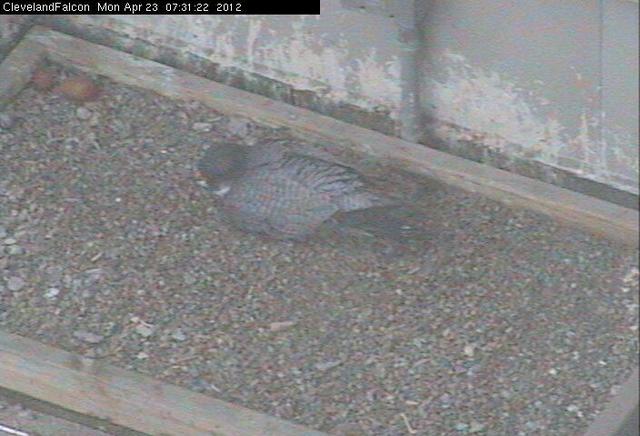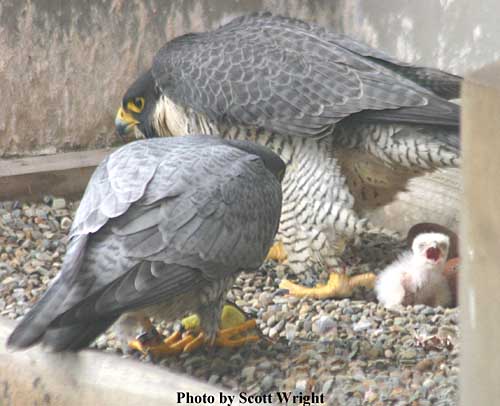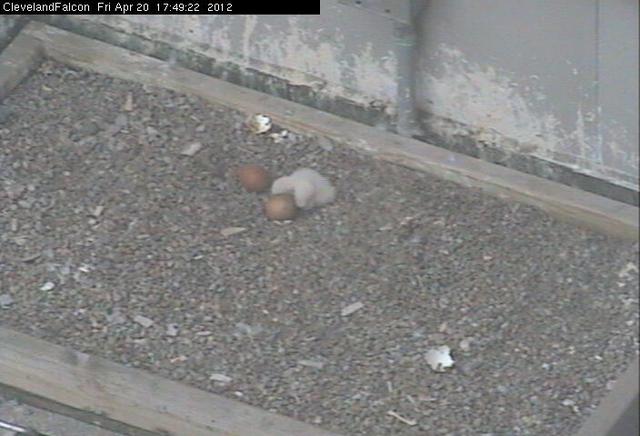FALCON FLASH
Dateline: Cleveland, Ohio
April 25, 2012
Click here to read what happened earlier
The eyass will grow and change very fast for the next 6 weeks. Check out a picture guide and information about eyass growth at The Canadian Peregrine Foundation:
To watch the falcons live go to: http://www.falconcam-cmnh.org/news.php
Our thanks to the Cleveland Museum of Natural History for sponsoring the FalconCams and for the stills.
Photos are courtesy of Scott Wright, volunteer peregrine nest monitor. They may be used in any non-commercial publication, electronic or print, but please give photo credit.
Throughout her nesting history, SW has had 3-4 chicks (properly called “eyass”) hatch and grow up in the nest. This year, however, the hatching has been very different. As you know, the first egg began to hatch, but the little eyass inside was not strong enough to break through, and it did not survive. Falcon fans were happy to see the second egg hatch normally. An interesting note is that a day or so after the successful hatch, SW or Boomer somehow removed the first failed egg from the nest.
Then came more bad news. The third egg appeared to be in the process of hatching because a pip was visible on the FalconCam on Saturday.hen came more bad news. The third egg appeared to be in the process of hatching because a pip was visible on the FalconCam on Saturday.
But on Sunday, we saw that Boomer “kicked” the third egg away, and the parents stopped incubating it.
The weather was cold at the nest, and the parents would not have stopped incubating the egg if the little eyass inside were still alive.
Early Monday morning, the eyass and one egg appeared together on the FalconCam……
But shortly afterward, SW moved the last egg away and stopped incubating it. We do not know whether there had been a hatch in process or not.
Why is this happening? Some falcon fans wonder if it is because of the weather, which was unusually warm in March. SW laid her eggs earlier this year than she normally does. You may also remember that there was an unusual pause during the time SW was laying eggs, whereas in the past she would lay her eggs like clockwork. Reports have come in from other peregrine falcon nestsites that this spring has seen changes in egg laying and hatching patterns. Very probably, however, it may be that SW is getting old. Mr. Harvey Webster, Director of Wildlife Resources at the Cleveland Museum of Natural History tells us: “SW is 13 years old. Falconers that propagate Peregrines in captivity often report that productivity dramatically drops by the 14th year and they usually retire their birds from breeding at that time…….. SW is creeping up on that age where you might expect to see some egg failure”.
The good news is that the one eyass seems normal and is eating well. Boomer is a wonderful provider, so this little one should be extremely well-fed. An “eyass” eats the same food that adult falcons eat, but SW tears the meat into very small pieces.
Volunteer nest monitor, Mr. Wright, has visited the nest and reports that Boomer is nervous to see a human behind the skyscraper window watching his family, so Mr. Wright has been very careful not to upset him. Here is a picture of Boomer on the skyscraper ledge giving Mr. Wright an angry look.
Click here to read what happened next







